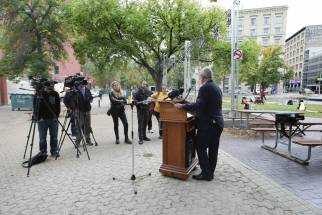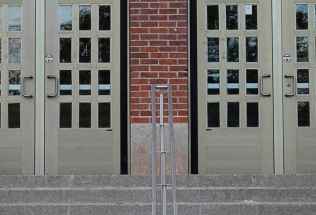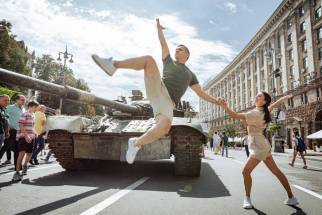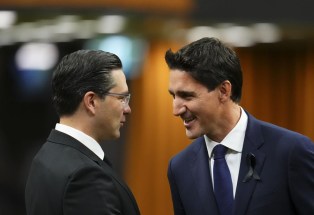Arts and minds Battered, but unbroken, war challenges Ukrainians to consider identity, sparks interest in homegrown cultural forms
Read this article for free:
or
Already have an account? Log in here »
To continue reading, please subscribe:
Monthly Digital Subscription
$0 for the first 4 weeks*
- Enjoy unlimited reading on winnipegfreepress.com
- Read the E-Edition, our digital replica newspaper
- Access News Break, our award-winning app
- Play interactive puzzles
*No charge for 4 weeks then price increases to the regular rate of $19.00 plus GST every four weeks. Offer available to new and qualified returning subscribers only. Cancel any time.
Monthly Digital Subscription
$4.75/week*
- Enjoy unlimited reading on winnipegfreepress.com
- Read the E-Edition, our digital replica newspaper
- Access News Break, our award-winning app
- Play interactive puzzles
*Billed as $19 plus GST every four weeks. Cancel any time.
To continue reading, please subscribe:
Add Free Press access to your Brandon Sun subscription for only an additional
$1 for the first 4 weeks*
*Your next subscription payment will increase by $1.00 and you will be charged $16.99 plus GST for four weeks. After four weeks, your payment will increase to $23.99 plus GST every four weeks.
Read unlimited articles for free today:
or
Already have an account? Log in here »
Hey there, time traveller!
This article was published 23/09/2022 (1173 days ago), so information in it may no longer be current.
KYIV — Do you start with the war? The normal thing, maybe, would be to start with the war, with the morning that bombs burst over Kyiv, gunshots cracked in the streets and two dancers took their eight-year-old son and fled to a basement, from which they didn’t emerge for two weeks. That’s when much of the world turned its eyes to Ukraine, at least.
But Maksym and Viktoriia Karpenko’s life didn’t start on Feb. 24, nor did Ukraine’s, so maybe the story shouldn’t start there either. Maybe it ought to begin 20 years ago, when Maksym was just 15 years old and freshly arrived in Kyiv from Luhansk, a city in the eastern Donbas region that forms the industrial spine of Ukraine.
He’d come to the capital to dance. Four years earlier, Virsky, Ukraine’s national folk dance ensemble, had come to Luhansk, and young Maksym, who’d been taking children’s dance classes, went with his family to see the professionals at work. Their tickets weren’t great — up in the balcony, far from the stage — but even from that vantage, he was mesmerized.
“I felt the full spectrum of emotions,” Maksym tells me one night, over wine at a chic Kyiv café, as his sister translates.
From that moment, Maksym wanted to become a Virsky dancer. It was the way they moved, he said, so precise, so powerful, with leaps that seemed to break the chains of gravity. It was hard work, but eventually he passed the exams to be accepted to Virsky’s preparatory school in Kyiv, where he arrived with his father as a wide-eyed teen.
Those first weeks in the capital were difficult. It was hard to move to the big city with no friends at such a young age: “Of course, I was crying sometimes,” he says. For a while, he would go back to Luhansk every couple of weeks. But slowly, the days got easier, because he was entranced by learning Virsky’s style of dance. Plus, there was Viktoriia.
It’s a cute story, how they got together. He was smitten with her immediately. But Vika had grown up in Kyiv, a star student at Virsky’s prestigious youth dance school, and her tight-knit group felt competitive against the new kids, like Maksym, who came from non-professional classes in outlying cities: she “wasn’t too eager to talk to them,” she says with a laugh.
Manuel Orbegozo/ for the Free Press Maksym and Viktoriia Karpenko, both dancers with Virsky, Ukraine’s national folk dance ensemble, stand with a commandeered Russian tank in Kyiv recently.
But four years later, they ended up in the same group. They were poor students still, so one night he bought a dinner of fried chicken from the supermarket for a date, and before long, she liked him too. Fifteen years ago they were married; they had a son, who’s now eight years old; and they danced, which sent them as cultural ambassadors all over the world.
To understand the role of Virsky in Ukrainian culture, you have to understand its history. The company was founded in 1937 by Pavlo Virsky, a ballet master from Odesa who’d trained in Moscow. As part of the Soviet cultural program, he developed a new type of choreography, which interpreted Ukraine’s freewheeling village folk dances with balletic precision.
“To children, Virsky company is the gods of dance,” Vika says. “Every step, every hand movement is corrected how it should be. This is right, and this is not right… From an early age we are taught how to move our head, how to make a look, whether we should lower our hand or make it higher. All these details make our ensemble very special.”
That academic approach to folkloric dance created a new style, one that is technically rigorous and physically demanding. It is not, strictly speaking, traditional, in either its choreography or its costumes; there are ongoing debates about the loose, billowing pants male Virsky dancers wear, which some cultural scholars argue are a misrepresentation.
Still, the style would come to dazzle audiences, first in the Soviet Union, and later all over the world. It would come to have a particular impact in the Ukrainian diaspora, where dance had become a powerful way for Ukrainian youth to hold on to their roots; on various tours of Canada, the spectacle that Virsky delivers influenced generations of dancers.
“They’ve taken Ukrainian dance to a different level,” says Hannah Picklyk, who grew up in Manitoba and now dances with the Selkirk-based Troyanda Ukrainian Dance Ensemble. “Ukrainian dance has evolved so much partly because of Virsky. A lot of groups draw their inspiration from what Virsky does. It’s the power in their bodies. They make it look so easy.”
That inspiration has formed ties that bind the communities close. In 2017, Picklyk, who also co-hosts a podcast called Vsi to explore Ukrainian identity and culture, went to Ukraine as part of a program to study with dance groups across the country. In Kyiv, she spent weeks observing Virsky and training at their studio, where she met Maksym and Viktoriia.
“Our meetings were more like watching them in awe,” she recalls. “Everyone in the Virsky company are very inspirational as dancers. They’ve dedicated their life to this. It’s inspiring to see them go into the studio day after day and work so hard… it’s inspiring for people who wanted to do this professionally, but also for us Canadians, who’ve never danced professionally.”
One effect of these relationships, Maksym and Vika say, is that in some ways, Virsky is more admired in Canada than it is at home. In Ukraine, as in much of the world, the shine of American-dominated global culture beckons; youth in Ukraine now want to learn hip-hop and contemporary dance more than Ukrainian styles, the couple says with a sigh.
“In the diaspora, they try not to forget their origins and try to cherish this culture, to tell about it to their children, to their grandchildren and so on,” Vika says. “They try to dance. We here do what we can do… We want our culture to stay on this level and even higher. We want these dances to make shivers down your spine, and make it professional.”
So on tours outside Ukraine, through diaspora communities in Brazil and Argentina and Canada, they found a community eager to embrace them. Canada in particular became a favourite place to visit: Maksym and Viktoriia loved the nature, and the people. They made friends in Edmonton, and sometimes wondered what it would be like to move there.
Ultimately, they decided that they wouldn’t leave: they love Ukraine. They have their work and their family, and “everything is fine in Ukraine except the war, unfortunately,” Vika says. But if they ever did move, Canada would be the only place they’d want to go. They’re teaching children Ukrainian dance now, and they could easily keep doing that in Canada too.
MANUEL ORBEGOZO PHOTO Virsky dancers Maksym and Viktoriia Karpenko for Melissa’s 498 feature on Ukrainian arts, culture and identity. Sept. 1, 2022
Suddenly, Maksym frowns, remembering something that happened, many years ago.
“There was an incident in Canada,” he says.
The incident: they were touring Canada, performing for the usual audience of Ukrainian diaspora and fans of folkloric dance. After rehearsal, a big group of Ukrainian-Canadians wearing vyshyvanka — traditional embroidered shirts — came up to take a photo with the dancers. As they chatted among themselves, mostly in Russian, a woman turned to glare at them.
She was furious, Maksym recalls, bitterly reprimanding them for speaking Russian: they were with Ukraine’s national dance ensemble, she said, so they should be speaking Ukrainian. She seemed “radically patriotic,” Vika says, and her anger shocked them; the dancers, many of whom, like Maksym, came from Russophone regions of the country, were offended.
“She was saying ‘I’m living in Canada, I’m doing this, I’m doing that, I’m doing everything for Ukraine,’” Vika recalls. “But we were offended because we live in Ukraine, we represent our country all over the world, and we share Ukrainian culture with our dance, with our moves, without speaking.”
I’m sorry that happened, I tell them. But Maksym shakes his head; that’s not what they’re trying to convey.
“She was an older woman,” Maksym says. “She knew more about Ukrainian identity and history, and knew more about how is the better way to represent Ukraine, the right way to represent Ukrainian culture. These were things we didn’t understand then and didn’t think were important at our young age.”
So what he’s saying is, while she could have been nicer about it, he and Vika have come to feel that the woman was right?
Maksym nods. It’s different now, he says. Back then, he’d told that angry Ukrainian-Canadian woman that “to be Ukrainian is to work for Ukraine, not to tell us what to do.” Now, he thinks, “to be Ukrainian is to work for Ukraine, but also to tell that you are Ukrainian out loud, with all our identity,” which includes embracing its unique language.
Vika chimes in to agree. “If we come to Canada today, no-one will be speaking Russian,” she says.
Is that change just since the war?
Maksym nods solemnly. “We understood that in 2014.”
And now, we come to the war. For them, it did not begin this year; it began in 2014, when Russia-backed separatists took control of the Donbas cities of Luhansk and Donetsk. Maksym’s grandmother refused to leave Luhansk — like many elders now in occupied parts of Ukraine, she vowed to die where she was born — and so his mother wouldn’t either.
Flash forward to Feb. 24. That morning, Maksym and Vika were woken up by frantic calls from her mother. Outside their window, they saw traffic jams of terrified people fleeing Kyiv. They got two messages from Virsky’s director: the first said that dancers could still come to work if they wanted. Ten minutes later, a second message: stay home, and stay safe.
MELISSA MARTIN / WINNIPEG FREE PRESS Photos of Irpin, a wealthy suburb of Kyiv, in ruins six months after the full-scale Russian invasion. For Melissa’s 498 feature on Ukrainian arts, culture and identity.
It was early in the morning. Their son was still sleeping. Vika began stuffing a suitcase, preparing to flee; but in the end they never left Kyiv. Instead, they went to their basement, and stayed there for two weeks. They ventured upstairs only to use the bathroom, or warm up, or make tea. Their son got sick, as did Vika’s mom. It was terrifying, but they got through.
Then suddenly, four weeks after the war started, they learned they had work to do.
On a day in late March, one month after the war started, most of Virsky’s 60 dancers gathered in Lviv, ready to strike out on a fundraising tour of Europe. The emotions were heavy; many had family trapped in occupied regions. But they felt they had a responsibility to represent Ukraine, so at least they could do something. They called it the cultural front.
“Mi privezemo peremohu,” the dancers kept saying to each other, in Ukrainian. We will bring victory.
For the next month, they travelled all over Europe, from Poland to Spain, from Czechia to Italy. In Warsaw’s main square, they stumbled on a rally in memory of the civilians who had been killed while sheltering at a Mariupol drama theatre that was bombed; Virsky’s male dancers approached the organizers and offered to dance, right there, without music.
As 5,000 people gathered in the square watched, the dancers silently went through their movements, and wept.
“It was hard in the first concerts because you have to go out on the stage to show emotions, and how great Ukraine is, how it is happy and strong,” Vika says. “But deep in your soul, you can’t do that. On the first concerts, when we smiled, it was half, like no emotions inside… but how (audiences) greeted us, the tears, the emotions, we always felt their support.”
Five months later, back in Kyiv, the war situation has stabilized. Kyiv is no longer under threat, other than from increasingly occasional air alerts. Maksym’s mother and grandmother are relatively safe in Luhansk, though that could change if the front moves closer to that city; his father is in Nikopol, across the Dnipro River from the nuclear power plant in Enerhodar.
In recent weeks, as tension ratcheted up around the plant, Nikopol has come under heavy shelling. But Maksym’s father won’t leave, other than for short visits to Kyiv; he’s the director of a factory, and he’s determined to keep an eye on it. Maksym and his sister have tried to convince their father to stay with them in the capital, to no avail.
MANUEL ORBEGOZO PHOTO Virsky dancers Maksym and Viktoriia Karpenko perform a dance move repeatedly until it is perfect.
So they worry about that, but otherwise their lives have continued. Virsky has resumed rehearsing, though it’s not quite back to business as usual: a planned performance last month was postponed due to fears of an air strike. They want to do more to help, too, such as touring to entertain soldiers near the front, as Ukrainian singers and comedy stars have been doing.
And they think about what role the arts will play in the future of Ukraine. “Maybe our country lost some time that it didn’t pay a lot of attention to the culture,” Maksym says, but already he sees that changing. As the war challenges Ukrainians to consider their identity, there has been a renewed interest in homegrown cultural forms, and that includes Virsky.
“We see Ukraine to become even more stronger now, after all this ends, after we win,” he says. “The famous phrase now is that Ukraine is reinventing itself and all the Ukrainians are reinventing ourselves. We’re reborn. Now we’re becoming true Ukrainians. It’s a new system update. Unfortunately, we have to pay a high price for that.”
So what will happen, when the war ends? Maksym smiles, and thinks to what he’s seen of world-famous musicians who have publicly supported Ukraine. He points out how artists such as Imagine Dragons and Coldplay and Sting have shown support for Ukraine at their concerts, and even collaborated onstage with Ukrainian musicians.
“When there will be a victory day, they will come here and we will have a big party in the streets,” he says. “And of course, we will dance our Ukrainian dances.”
On a café patio in Lviv, over $3 margaritas and a pile of varenyky, I tell my friend Mira that I plan to interview dancers in Ukraine. She frowns a little. Mira is usually an online English teacher, but since the full-scale invasion she, like countless English-speaking twenty-somethings in the country, has helped journalists and aid groups in need of a translator.
“Is this important right now, you think?” she says, wrinkling her nose skeptically. “This dancing?”
For a minute, I’m not sure how to reply. It has ties to my community at home in Canada, I tell her. There’s something I want to explore about culture, and how it can hold an identity that crosses time and space, connecting places and generations. It’s about the relationships and conversations culture can foster, especially now, when that culture is under such pressure.
MELISSA MARTIN / WINNIPEG FREE PRESS Denis, a member of the Territorial Defence Force from Irpin, in front of the ruins of a high-rise apartment block totally destroyed by bombs. For Melissa’s 498 feature on Ukrainian arts, culture and identity.
Mira seems unconvinced. “Most journalists, they want to see bombings,” she says, with a shrug. “Dead people.”
Yeah, but that’s the thing. On most days, you can turn on news about Ukraine and see stories about dying. But the living is important too. Has to be important. Has to be cherished and protected and retained. After all, without the living, what are you even fighting for?
She sips her cocktail, and thinks about this for a minute. “Yes, I see what you mean.”
First, a confession: when Stacey Yerofeyeva left Toronto in August, she promised her friends that she wouldn’t go to Ukraine. They were scared for her. Don’t worry, she told them. She would stay in Warsaw where it was safe, and where she planned to volunteer at the main train station, where destitute displaced Ukrainians still arrive every day.
As she prepared for the trip, Yerofeyeva — a professional singer in Toronto, who performs under the name Nastasia Y — felt waves of emotion. She’d been born in Kyiv, and lived there until her family moved to Canada in 2001, when she was 11 years old. She worried that seeing her people’s suffering up close would be too harrowing, too heavy to bear.
But she knew she had to go. For the last six months, the war had consumed her. At home in Toronto, she found it difficult to work, difficult even to think; she cried every day during the first month, and after that at least twice a week. She found solace only in the blissful moments just after waking, before the reality of the war in her homeland hit her all over again.
“My mind was just constantly here,” she says, chatting one night over dinner at an Argentinian steak house in Kyiv. “For me, it was war. And then, just going down to the street, seeing people living normal lives, some not even realizing that the war is still happening, like ‘is that thing still going on in Ukraine?’ My whole life was war over there (in Canada).”
MELISSA MARTIN / WINNIPEG FREE PRESS Yerofeyeva, a musician from Toronto, strolls along the Dnipro River in Kyiv.
After landing in Warsaw, she threw herself into her volunteer work, helping mostly women and children spending the night at the train station before heading elsewhere. They cried a lot together, and laughed a lot; she was invited to sing at a charity concert. She documented the emotional journey on Instagram, sharing the devastating stories of the refugees she met.
Yet as the days in Warsaw went on, Yerofeyeva felt more and more pulled to Ukraine. She had a particularly urgent reason to go: in March, her grandfather’s house in a village east of Kyiv had been shelled, leaving it ruined. But the house is all he has in the world, especially since his wife died in October, so he refused to leave.
With winter approaching, Yerofeyeva was growing more worried. There was, it seemed, nobody to help her grandfather; he has few relatives, and Ukraine’s government does not have the resources to rebuild every ruined home. His health is fragile, but he’s been sleeping in the kitchen of his windowless, unheated home. The joy he once embodied was fading.
“He’s really changed since the war,” she says. “Before, he was a very happy person. He hasn’t fully really laughed or smiled since the war started. Even when I called him when I was in Warsaw, I asked how he was and he said ‘not good.’ Which is almost unheard of, for my grandpa.”
So yes, she’d promised her friends she wouldn’t go to Ukraine. But she did. One night, almost on impulse, she bought a bus ticket to Kyiv, told the group she was volunteering with that she had to leave — which they understood — and within hours, she was gone. As she crossed the border that night, just after 1 a.m., she felt her heart flutter.
“I just felt this excitement that I was going home, to this place that they’re trying to take away from me,” she says.
In Kyiv, Yerofeyeva stayed in an apartment with distant relatives. She travelled to her grandfather’s village to be with him, and to find someone who could rebuild his house. (No luck yet.) And she immersed herself in Kyiv, exploring its familiar streets, dining at its restaurants, and talking to everyone she met about how they were getting by.
“People just keep going, and in fact they’re less hopeless than what I was feeling, or a lot of my community I think overseas was feeling,” she says. “Here, there’s this sense of just living your life, which in itself is an act of resistance. And also, being able to do something, whether it’s as big as rebuilding a school, or as small as donating change to the army.
“It’s somehow easier being in it. It’s just what’s been happening for hundreds of years, and that’s the answer that I got from people,” she adds. “This is just the continuation of it… it is a huge thing. It’s war. But you just keep living. They do. And now, maybe I’ve accepted it now that I’ve seen how people here live, and especially how united they are.”
As she saw that, something happened that she was not expecting: she felt the weight that had been so heavy on her shoulders in Toronto lifting. She’d worried that going to Kyiv would be emotionally devastating, but it was the opposite, she says. Every day she was there, she felt a little lighter, and for the first week in six months, she didn’t cry once, in Ukraine.
“For me, it’s been really healing,” she says. “I feel much better being here. It’s seeing that people are OK, or not that they’re OK, because the situation is terrible. The situation with my family is terrible. But any person that I’ve talked to, when I say something like, ‘this will end and we’re going to win,’ they say ‘absolutely, 100 per cent.’ That has been healing.”
On the night we met, her trip was winding to a close. She was looking forward to the days ahead, and to her journey back to Toronto. After Feb. 24, she and a group of fellow musicians launched a project, Sing With Ukraine, to hold workshops and concerts of eastern European folk music; that too is a form of resistance, and she has many plans for its future.
SUBMITTED Stacey Yerofeyeva sits with her grandfather, whose home in a village north of Kyiv was damaged by Russian shelling.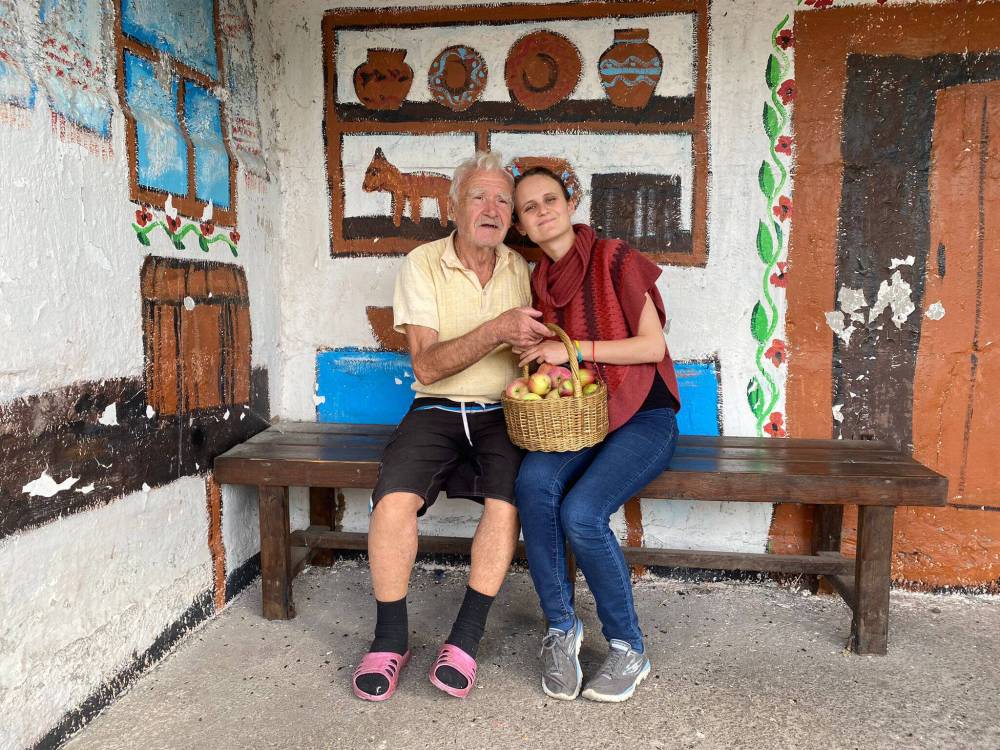
Above all, she realized, she could start thinking about her own life in a way she hadn’t been able to since the invasion.
“I’m really going to try to get my life back in some sort of balance, some sort of a routine like I did before,” she says. “Like waking up and stretching in the morning. It’s been so difficult to not go on the news, so I’m still working on that. But I feel like it will be a little bit easier now that I’ve been here and talked to so many people, and just seen it all.”
As our conversation wraps up, there’s about an hour left before the 11 p.m. wartime curfew kicks in. We leave the restaurant and take a lazy walk down to a dreamily-lit pedestrian path along the Dnipro River, where couples and families are strolling in the crisp breeze of early September. There’s one last thing Yerofeyeva has been thinking about, and wants to say.
While in Ukraine, she met a group of volunteers who are rebuilding a school in Hostomel, which had been obliterated in the fighting. She was telling them about how there are a lot of Ukrainian-Canadians who would love to come help rebuild, after the war. But one of the volunteers said something that struck her about how critical it is to seize back the living.
“The time to rebuild is now,” he told her. “If you wait until after, it will be too late.”
If you come to Ukraine now, at this juncture in the full-scale invasion, this is what you will see: Ukraine is ruined, and not-ruined. It is deeply wounded, and it is thriving. It’s both things, enduring together, side-by-side and somehow without any contradiction. It’s a big country, and the violence hasn’t battered it equally, but more than that, it is unbroken.
On my last morning in Kyiv, Nelia Nyuhova picks me up from my hostel and takes me on the short drive to Irpin, a wealthy and once-beautiful suburb linked to the capital by a picturesque tree-lined road. In the backseat, her daughter sits absorbed in her iPad, doing online classes. The teacher’s encouragment — “Dobre, dobre” good, good — is our soundtrack.
Nyuhova has only been in Kyiv for a few weeks. She was actually living in Moscow when the full-scale invasion began; she’d been transferred there two months earlier, to run her company’s regional sales office. On Feb. 24, she immediately began to make her way out of Russia, taking a looping route to Ukraine to gather her kids and flee to Romania.
Now, she’s hoping to move to Winnipeg. Her house in Konotop, in the northeastern edge of the country, was destroyed, she feels anxious all the time, and Ukraine’s economy is struggling. She’s researched Canada and thinks Winnipeg would be the best place to go: there are lots of Ukrainians there, she’s been told, and maybe an opportunity to start over fresh.
She has a lot of questions about Winnipeg. She wants to know if it’s easy to live there without a car, or whether there would be a market there for her to try a new career doing manicure art. She wonders how she can find a family to host her and her daughter while they get on their feet: she’s been trying to find someone on Facebook, but so far has come up empty.
For now, though, she has a friend she wants me to meet: a young woman from Irpin, who chose to stay in the city during the desperate first days of the invasion, when Irpin became the site of one of the war’s most visible humanitarian crises: photos flew around the world of civilians trying to flee under a blown-up bridge, as Russian shelling pounded nearby.
Nyuhova’s friend was one of the territorial defence members who helped in that evacuation. She and two men from the same defence unit meet us in front of tall apartment blocks destroyed by bombs launched from fighter jets; all that’s left is now are piles of broken concrete and warped metal twisted around tattered blankets, filthy toys and smashed tiles.
For the next two hours, the soldiers take us around the wreckage of Irpin, pointing out where their unit fought pitched street battles against Russian forces and where people they know were killed. Nyuhova does her best to translate what they say, but it’s difficult for her to find all the English words, so for the most part the damage speaks on its own.
MELISSA MARTIN / WINNIPEG FREE PRESS Irpin, a suburb of Kyiv, was left in ruins six months after the Russian invasion.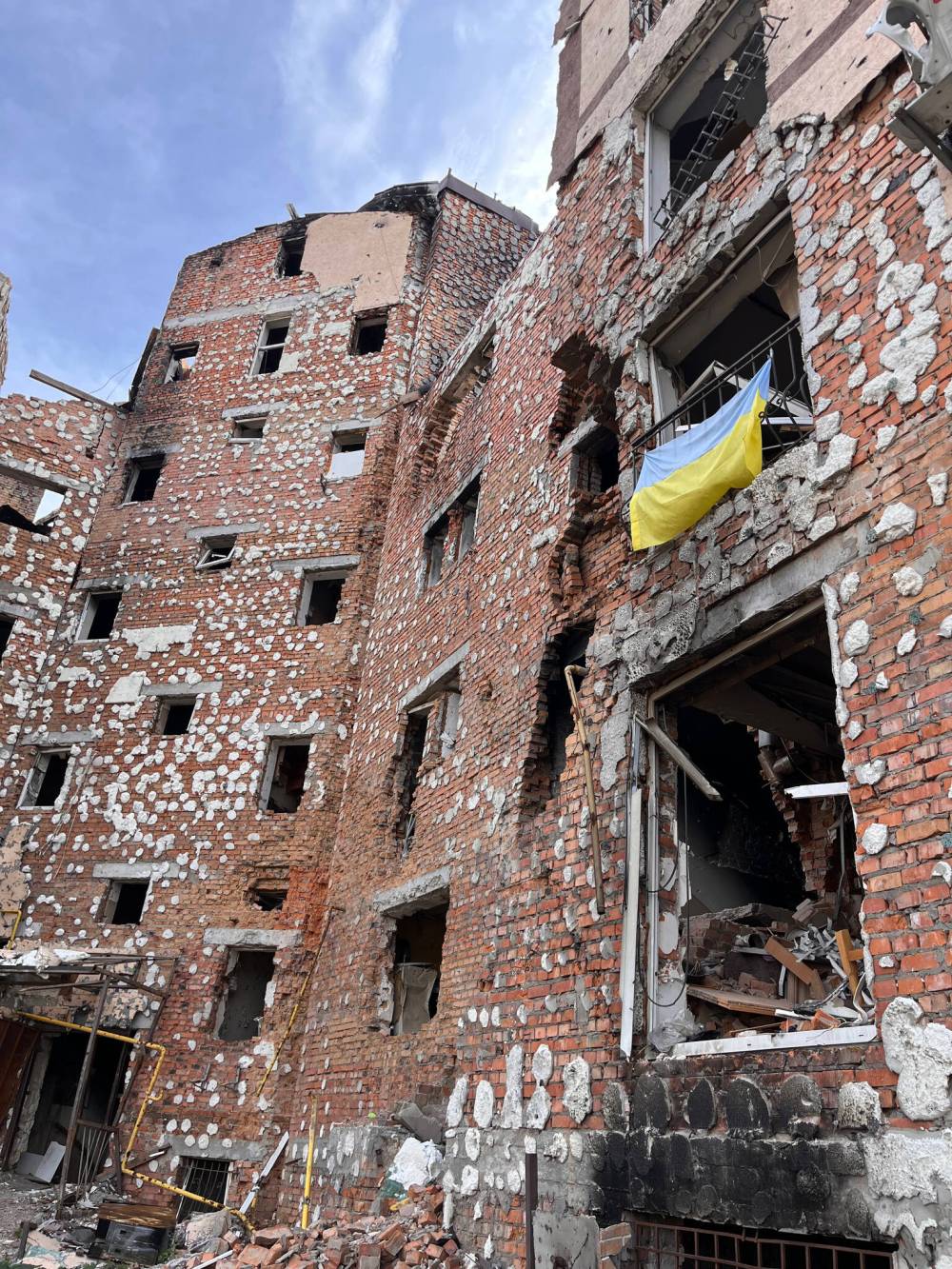
The scale of Irpin’s destruction is almost impossible to capture, in words or in photos. When the city, which had a pre-war population of about 60,000, was first liberated in late March, its mayor estimated that at least half of it was destroyed. We see a shopping mall, hollowed and obliterated. A whole neighbourhood reduced to rubble and riddled with bullet holes.
Nyuhova tells the soldiers I want to see the bridge that had made front-page news across the world. So they drive there, and talk about the terrifying evacuation. One of the soldiers takes out his phone, to show me a video he’d taken that day: it pans to show the corpse of a man lying halfway out of a vehicle, face-up with wide-open eyes. I flinch and turn away.
The soldier responds to my discomfort with a sad half-smile. He’s seen things that can’t be unseen; and, now, so have I.
On the edge of the bridge, I sit for a minute and gaze over a scene that had been burned into my memory, from those photos taken during the evacuation. It looks nearly the same as it did in those images, though now there is a peaceful sky, and signs of hope: several construction cranes loom beside the bridge, preparing to rebuild what war has destroyed.
Behind me, Nyuhova and the soldiers chat quietly. I want to tell them why it was important for me, as a writer, to come to this place and witness the damage, even all these months later. Even after the crisis had passed, and many journalists had come and gone, and the eyes of the world have turned away from Irpin. You have to see things, to know them.
All I can manage are a few words of broken Ukrainian: “Zaraz, ya rozumiyu.” Now, I understand.
That afternoon, Nyuhova drops me back off at my hostel. It’s my last night in Kyiv, so my friends and I go out bar-hopping in the old heart of the capital, drinking vodka Sprites. We poke our heads into a standup comedy show, groove to a Latin dance band and, after the 11 p.m. curfew, retreat to our hostel to cap off the night singing along to Ukrainian pop music.
A few days earlier, a video had gone viral online, showing Ukrainian youth dancing at a nightclub in the capital. Some who saw it shared it on social media with a sneer: “look at how they’re suffering in Kyiv,” one person wrote. To people critical of the West’s support for Ukraine, the video was a sort of proof that the nation’s struggles were a media fiction.
I watched the debate with interest. I hadn’t been to that exact venue in Kyiv, but I’d been to ones like it, smiling to see young people laughing and flirting and doing shots at the bar. Some of them are displaced from the east and south; many have lost their homes, and some have had family killed. But they dance because they’re still alive, and still young.
Walk down any street in Kyiv, and you see women in effortlessly chic dresses, breezing past piles of Czech hedgehogs left on the sidewalks from when Kyiv’s streets were full of barricades
And I thought back to how, in July, when Ukraine’s first lady, Olena Zelenska, posed for a Vogue photoshoot with famed photographer Annie Leibovitz, it sparked a massive controversy both in and outside of Ukraine. To some, the shoot was a slap in the face to those suffering, or a gross romanticization of war, or an out-of-touch display of elite vanity.
Yet in a way, the criticism that erupted missed something revealing about the images: they do capture the essence, if not of Ukraine as a whole at this moment, then at least of Kyiv, the capital. Zelenska in an elegant blouse, sitting in front of a wall of sandbags: that is Kyiv, now. Zelenska in a tailored coat, beside a ruined airplane: that is Kyiv, now.
Walk down any street in Kyiv, and you see women in effortlessly chic dresses, breezing past piles of Czech hedgehogs left on the sidewalks from when Kyiv’s streets were full of barricades. Visit Irpin, and you can see youth lounging in a verdant park, laughing under the shadow of a high-rise apartment building gutted and blackened by bombs.
But will the world understand that, if it sees it? For Ukrainians, it’s a difficult question. If the West sees the parts of Ukraine that are unbroken, that are vibrant, that are neither cowering nor dying, will it still send the humanitarian aid and weapons Ukraine needs to fight? Can it understand how a country can be ravaged, but still have fashion, dancing and wine?
In other words, is the price of global compassion for Ukraine, or for anyone, that they must not only suffer, but be seen only as suffering? That they be reduced, in their struggle, to a static picture of victimization? Or to go back to an earlier question: is the living not also important? Is it not, in fact, everything? If it is, then that life should be celebrated all the more.
“Ukraine has not yet perished,” goes the first line of the country’s national anthem.
Sometimes also translated as: “not dead yet.”
It’s Aug. 27, and Kyiv is burning in the sun, which has beaten unyielding on the city for weeks. The day is cloudless and 35 C. Three days earlier, Ukraine had marked its Independence Day, and in lieu of the typical grandly choreographed parades, the government organized a so-called “parade of Russian military technology” through the heart of downtown Kyiv.
The display of captured and destroyed Russian weapons is vast, stretching 650 metres down the broad Kreshchatyk Street, past the historic Maidan Square and towards the sparkling Dnipro River. There are dozens of scorched tanks and shredded fighting vehicles, a mangled Pantsir anti-aircraft system, a pile of rockets which landed on Ukrainian cities.
For days, Ukrainians have flocked to the display, slowly wandering between the husks of Russian vehicles. Police won’t let visitors climb on top of the wreckage — it’s not safe — but otherwise let them do what they want. People stub out cigarettes on the charred remains of tanks. They cover the vehicles with graffiti, naming their ravaged hometowns.
“For Kherson.” “For Kharkiv.” “For Mariupol.”
In front of this sea of weapons, Maksym and Viktoriia Karpenko, the Virsky dancers, pose for a photographer. At first, they are just standing still in one of their dance’s starting positions, but then they have another idea: it would be better, Maksym suggests, to do one of their full dynamic movements. The photographer, intrigued, invites them to give it a try.
With that, Maksym and Vika take their position, arms outstretched, grasping hands. A heartbeat later, Maksym leaps in the air, legs kicking upward, spine arching back. It’s a wondrous movement, breathtaking even without the lights and costumes of the stage, a body rising against gravity. The throng of people milling about the tanks murmurs quietly.
MANUEL ORBEGOZO PHOTO Virsky dancers Maksym and Viktoriia Karpenko for Melissa’s 498 feature on Ukrainian arts, culture and identity. Sept. 1, 2022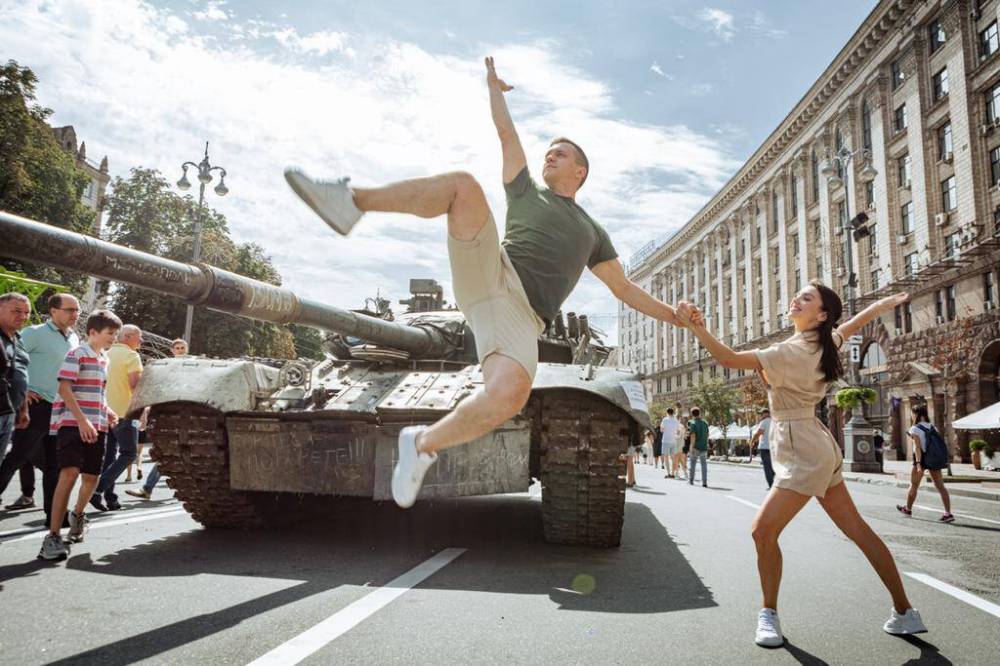
After he lands, Maksym rushes over to squint at the image on the photographer’s camera. He shakes his head, pointing out where his feet aren’t quite perfect: “one more,” he says. So he takes Vika’s hand, and they skip back into position to try the same move again, and again, and again. Until it is perfect, just like how they’d been taught.
Six months before, almost to the day, Russia had brought these killing machines to Ukraine. The war is far from over. You can turn on the news and see stories about the dying every day. Yet here, in the heart of the capital, broken metal makes a river of rust through the streets, and Ukrainian life dances on what remains.
melissa.martin@freepress.mb.ca
Our newsroom depends on a growing audience of readers to power our journalism. If you are not a paid reader, please consider becoming a subscriber.
Our newsroom depends on its audience of readers to power our journalism. Thank you for your support.
History
Updated on Friday, September 23, 2022 7:26 PM CDT: Corrects photo credits
Updated on Monday, September 26, 2022 5:41 PM CDT: Corrects to note Yerofeyeva's grandfather's is east of Kyiv.









